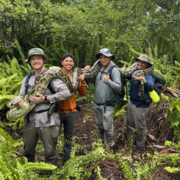Biosurveillance
Our early detection & rapid response are improving biological threat detection
Fish and Wildlife Disease
We are the lead Federal agency for wildlife disease research and surveillance
Biological Threats and Invasive Species Research Program
The Biological Threats Research Program delivers science to protect public safety, property, and ecosystems from invasive plants and animals and infectious fish and wildlife diseases that pose significant ecologic and economic threats to the resources of the United States.
Links to Cool USGS Web Tools
Explore powerful tools that provide immediate access to data and information on aquatic invasive species, wildlife diseases, and invasive plants.





